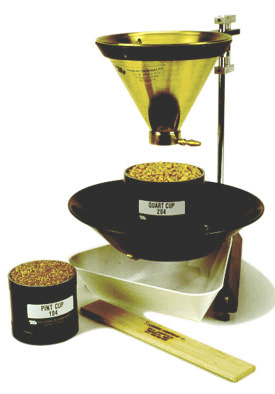By Bob Nielsen – Purdue University
Among the top 10 most discussed (and cussed) topics at the Chat ‘n Chew Cafe during corn harvest season is the grain test weight being reported from corn fields in the neighborhood. Test weight is measured in the U.S. in terms of pounds of grain per volumetric “Winchester” bushel. In practice, test weight measurements are based on the weight of grain that fills a quart container (37.24 qts to a bushel) that meets the specifications of the USDA-AMS (FGIS) for official inspection (Fig. 1). Certain electronic moisture meters, like the Dickey-John GAC, estimate test weight based on a smaller-volume cup. These test weight estimates are reasonably accurate but are not accepted for official grain trading purposes.

Fig. 1. A standard filling hopper and stand for the accurate filling of quart or pint cups for grain test weight determination. (Image: www.seedburo.com).
The official minimum allowable test weight in the U.S. for No. 1 yellow corn is 56 lbs/bu and for No. 2 yellow corn is 54 lbs/bu (USDA-AMS (FGIS), 1996). Corn grain in the U.S. is marketed on the basis of a 56-lb “bushel” regardless of test weight. Even though grain moisture is not part of the U.S. standards for corn, grain buyers pay on the basis of “dry” bushels (15 to 15.5% grain moisture content) or discount the market price to account for the drying expenses they expect to incur handling wetter corn grain. Continue reading Grain Test Weight Considerations For Corn
 By Amanda Douridas
By Amanda Douridas